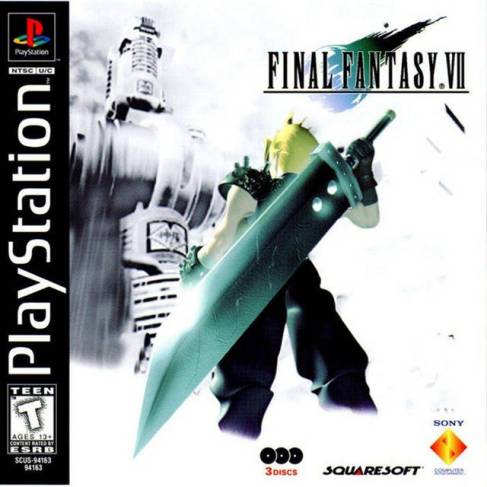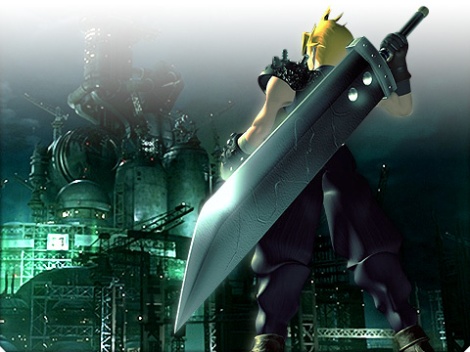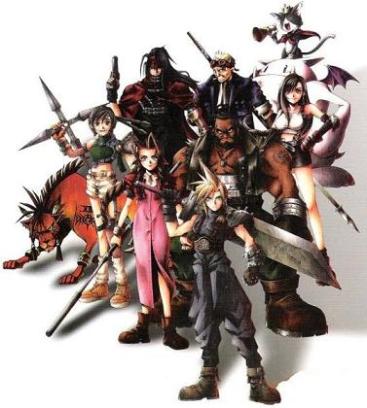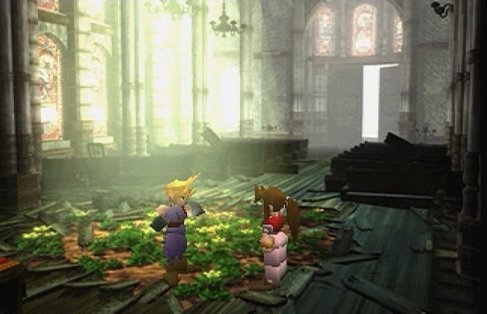
For all five of you out there, it’s been a while since I’ve posted a Retro(spective), but for a good reason; I had to make this 17th installment about Final Fantasy VII. Too much good synergy was going on with the multiple sevens, and it’s also been 17 years since the game bowed here in the states. This is one of the legendary games of the industry, so I wanted to go all out fact-finding for FF VII. A big part of this blog is back in action, and I couldn’t be happier. Without further ado… Retro(spective) 17-FF VII!
The very early stages of FF VII development began in 1994 for SNES before being sent to the back burner by Chrono Trigger. This momentum shift pushed FF VII further out and ultimately onto Nintendo 64. Final Fantasy series mastermind Hironobu Sakaguchi had been less involved with development of Final Fantasy VI, but that would change with VII. Sakaguchi knew the future of gaming was 3D, and that for Final Fantasy to remain relevant, it would have to be at the forefront of the transition under his guidance.
The first glimpse of what would become FF VII was seen at the SiGGRAPH computer graphics convention in LA. This SG1 demo, as it’s often called, featured characters from FF VI rendered with 3D polygons and fighting a golem. The demo was a showcase for what Sakaguchi was hoping to achieve with VII and filled people with excitement. Cinematically and technologically potent, SG1 was the seed from which everything would grow.
Most people, including the developers at Square, were anticipating FF VII as an N64 release. The entire series had been Nintendo-exclusive from the beginning, and with N64’s robust tech capabilities, VII seemed destined to continue that tradition. It would have happened, too, if not for one major problem; N64 wasn’t going to be CD-ROM based. Sakaguchi had been banking on Nintendo adopting the burgeoning format, as VII was going to be a data-intensive game that would need all the additional storage space CDs offered. Cartridges simply couldn’t contain as much data and were too expensive to produce. Nintendo was standing firm with its decision, though, and with no other choice, Square broke ties with the company.

While the split alone was a blow to Nintendo, it was worsened by Square’s choice of successor; Sony and its new PlayStation. The CD-enabled 32-bit system was already making life difficult, but to willingly add a bonafide Final Fantasy installment to its roster was going too far, in Nintendo’s opinion. Company president Hiroshi Yamauchi declared that a Final Fantasy game would never again appear on a Nintendo console and promptly sold off his company’s shares of Square’s stock. Square followed suit, and the two companies would remain in a cold war for years to come. It was a sad ending, but one that would ultimately benefit the development of VII.
Free of storage constraints, Sakaguchi was able to move forward with his project unhindered. Game director Yoshinori Kitase and co-writer Kazushige Nojima would prove indispensable during development, helping to focus and perfect Sakaguchi’s vision. Originally, VII was going to center around a group of young resisters being pursued by “Detective Joe”. Kitase quickly dumped Joe and shifted the focus of the story on AVALANCHE and Shinra, which in turn brought Cloud and Sephiroth to the forefront.
With the basics of battles cemented (including the return of Active Time Battles), actual rendering and creation of the world of FF VII became the biggest challenge. Most of Square’s staff had little to no experience working with new animation software like PowerAnimator and Softimage, which necessitated an injection of new blood. The influx of additional workers sent the number of staffers on VII skyrocketing, along with its budget, which easily exceeded its $40 million dollar allotment (along with Sony’s own $80 million dollar marketing push, VII became the most expensive game ever made, at the time). Though rookies with the software, Square’s staffers quickly took to it and began producing at a very high level.
The result of all this hard work was one of the most visually stunning games of that generation. Lush pre-rendered backgrounds conveyed the grandeur of sprawling Midgar, which had a riveting steampunk aesthetic. The characters were portrayed as very realistic during battle scenes, while in the overworld they appeared as super deformed and almost chibi-like. The odd mixture was surprisingly effective and suited VII well.

Sakaguchi hit a bit of a snag when it came time to enlist the aid of longtime Final Fantasy character designer Yoshitaka Amano. Amano was busy establishing art exhibitions and workshops in Paris and New York, which massively inhibited his ability to contribute to the project. While Amano would go on to design VII‘s signature meteor logo and assist with character sketches, the lion’s share of design work would be done by Tetsuya Nomura. The artist had only handled minor character and monster designs for FF VI, but was more than prepared to hit the ground running.
Nomura’s character designs for VII were a big departure from anything the series had seen. Cloud was an immediate hit with his giant sword and spiky hair, but he didn’t quite start out that way. Initially, Cloud had black slicked-back hair to contrast Sephiroth’s silver locks, but the designer thought he didn’t look heroic enough and added in the blond spikes fans know and love. (Interestingly, Cloud’s rejected design sounds an awful lot like what Zach Faire would go on to look like!). Barret once sported two hands and a bow-shaped gun, while Vincent went through an entire series of careers before settling on undead gunslinger. Nomura became so invaluable to the development of FF VII, that he was eventually given story input (more on that in a bit).
The narrative of VII was yet another departure for the series. Sakaguchi wanted to touch on a variety of high concepts that hadn’t ever been fully explored in a video game, such as the symbiotic relationship between man and nature, death and loss, and more. Kitase and company were integral to finding a way to express these ideas in a way that was clear and interactive within a video game. Beyond Sakaguchi’s own philosophical musings, there were practical matters to attend to, as well.
One such challenge was straying from the then-common conventions of the RPG genre. A typical omnipotent warlord or wizard wouldn’t do as the villain for VII; Sakaguchi had grown tired of that worn trope and wanted something different. The result was the evil mega corporation Shinra, the evolution of a traditional power threat in a modern setting. Primary antagonist Sephiroth was a different challenge, as he was already unique from a visual and background perspective, but was tough to tackle from a narrative standpoint. Rather than bombard the player with his presence, Sephiroth was instead shown sparingly throughout the course of VII in order to build him up in the player’s mind (Kitase compared this technique to what Spielberg did with the shark in his film Jaws). The theme of Sephiroth, One-Winged Angel, became the centerpiece of composer Nobuo Uematsu’s stirring score.

As the cast of VII grew, the team wanted to provide the player with a wide variety of characters to choose from, but felt that there needed to be more deviations from RPG traditions. One element that Sakaguchi was especially weary of was the hero sacrificing his life for his lady love, only to be resurrected later. After all, death without permanence held no meaning, and VII was a game of purpose. On a Sunday night during a collaborative phone call, Nomura suggested something that would hit Final Fantasy fans like a ton of bricks; kill heroine Aerith and establish Tifa as the true female lead. Sakaguchi loved the idea, and one of the most shocking moments in video game history was decided upon.
The impact of the death of Aerith can’t be emphasized enough. People literally went into a frenzy when Sephiroth impaled her. In the world of 1997, devoid of the internet as we know it today, desperate gamers reset, turned off, and in some cases, unplugged their PlayStations, convinced that there was no way Aerith was supposed to die. Players devoted hours to replaying the game, trying to find some way to prevent the tragic events, only to eventually realize that, yes, she was truly gone.
That Aerith could spark such a fervor of dismay is a testament to the advances in storytelling that FF VII brought to the industry. Players became wholly invested in the plight of Cloud and his companions during the game’s lengthy quest, picking and latching on to characters as one would those in a novel or film. The cinematic flourishes of VII would go on to become industry standards, and the intricate narrative inspired an entire generation of players and game designers.
VII isn’t without its detractors, as there are many who like to cite the game’s suspect Western translation and hefty number of returns, but there’s no denying the millions of copies sold and huge legacy left in VII‘s wake. What Sakaguchi, Kitase, Nojima, and Nomura accomplished redefined RPGs in Japan and cultivated legions of fans in the West who had never appreciated the genre in the past. While many of VII‘s themes and design choices have become overly replicated in the years since, it remains a highpoint of the industry and a true classic.
Released 1997. Developed by Squaresoft. Published by Sony.
Final Fantasy VII is available on PlayStation, PC and Steam. It is also available for download via PSN for PS3, PSP, and PS Vita.
















